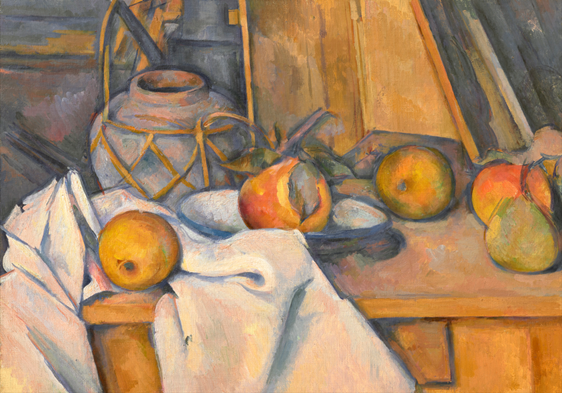THREE MASTERPIECES BY CEZANNE WILL HIGHLIGHT CHRISTIE’S NEW YORK20TH CENTURY EVENING SALE

PAUL CEZANNE (1839–1906)
Fruits et pot de gingembre
Painted circa 1890-93
Estimate: $35 million – 55 million
NEW YORK – Christie’s and the Foundation Langmatt Sidney and Jenny Brown are proud to announce three masterpiece paintings by Paul Cezanne will highlight Christie’s 20th Century Evening Sale taking place on November 9, 2023 during New York Fall Marquee Week: Fruits et pot de gingembre, Quatre pommes et un couteauand La mer à L’Estaque. This exceptional trio come to Christie’s from the collection of the Museum Langmatt in Baden, Switzerland, home to one of the most extraordinary collections of Impressionist art in Europe, assembled with care and passion in the early 20th century by famed collectors Sidney and Jenny Brown.
The lead highlight of the trio coming to auction is the exceptional Fruits et pot de gingembre (estimate: $35 million – 55 million). This iconic painting is part of a select group of canvases Cezanne painted in the late 1880s and early 1890s. With this work, Cezanne achieves a new level of sophistication in his treatment of still life, exhibiting a rich complexity in his formal approach to color and space. This painting hails from the coveted and important series of Cezanne’s still-life compositions now celebrated as his signature artistic achievements, alongside his Bathers series and his views of Mont Sainte-Victoire. The subjects within Fruits et pot de gingembrestand in dialogue with one another, assuming almost human-like characteristics. This work was most likely painted in the studio Cezanne kept at his parents’ estate on the outskirts of Aix-en-Provence – the same site where he painted his highly celebrated Card Players series.
| PAUL CEZANNE (1839–1906)Quatre pommes et un couteauPainted in 1885 Estimate : $ 7 million – 10 million | PAUL CEZANNE (1839–1906)La mer à L’EstaquePainted circa 1878-79Estimate : $ 3 million – 5 million |
The second work on offer, Quatre pommes et un couteau($7 million – 10 million) explores one of Cezanne’s favourite and most famous subjects – the apple. Having been largely absent from his work in the 1860s, the fruit, now inextricably linked to the artist’s identity, began to appear in Cezanne’s compositions with increased frequency in the 1870s, then throughout the rest of his career, in all types of arrangements and settings. In a move away from the spontaneity and broken touch of classic Impressionist technique which had dominated his body of workup to that point, here the artist uses a distinct and tightly “constructed” painting style, embracing a more structured technique and approach to formal rendering.
The final painting of the trio, La mer à l’Estaque($3 million – 5 million), is a serene landscape view, and the earliest of the three works, painted at the end of the 1870s. The oil on canvas encapsulates the growing boldness of Cezanne’s style during the time he spent looking out onto the vistas of L’Estaque, a picturesque fishing village on the Mediterranean coast that served as the setting for some of the most innovative landscapes of the artist’s career.
Dirk Boll, Deputy Chairman, 20th/21st Century Art, Christie’s EMEA, remarks, “Museum sales are highly sensitive processes. We were extremely impressed by the thoughtfulness and care with which the foundation and the management selected the works and managed the selection process. Christie’s brings decades of experience in dealing with museum sales, which are part of institutional practice in the Anglo-American cultural area.”
Max Carter, Vice Chairman, 20th/21st Century Art, Christie’s, continues, “Cezanne is the father of modern art, and many of his greatest works were last seen on the market within thirty years of his death in 1906. The trio of Cezannes from the Museum Langmatt was acquired in this vital period and represents two of the artist’s essential motifs and bequests to the generations that followed: his radical approach to still life and the view of the Gulf of Marseille from L’Estaque. We could not be more honored to handle this historic group, above all, Fruits et pot de gingembre, one of the most important and exquisite Cezanne still lifes ever to be sold at auction.”
Support for the Museum Langmatt
Bequeathed to the City of Baden, Switzerland in 1987, the villa Langmatt a historic family home built in 1900-01 was converted into a public museum and cultural institution which opened in 1990. It houses the significant Impressionist art collection of Sidney and Jenny Brown, privately acquired mainly between 1908-1919 with a few additional purchases over the following decades, and also presents regular series of contemporary art exhibitions and public programs. Since its opening, the Museum has required increasing levels of care, to maintain its aging physical facilities, which has substantially depleted the resources of the Langmatt foundation, Sidney and Jenny Brown. In 2017, the foundation launched “Future Langmatt,” a public capital campaign to identify solutions to secure the museum’s future. The city, with the help of the canton and third parties, pledged to contribute to the restoration of the property, and the foundation committed to secure a long-term and financially sustainable basis for the museum’s operations. The project was finalized and adopted on June 18, 2023 by public vote [an unprecedented 80% majority] in Baden. Museum Langmatt will receive substantial funds from the City of Baden and the Canton Aargau towards the museum’s renovation and restoration. The foundation Langmatt must now raise CHF 40 million / circa US$45 million for its endowment fund, providing the necessary interest rates for the long-term future of the museum’s operation.
Lukas Breunig-Hollinger, President of the Foundation Langmatt, Sidney and Jenny Brown: “The collection, which is important far beyond the country’s borders, is strongly linked to Baden. Exhibited in the former home of the Brown family of collectors, it has been firmly associated with the town for a century and is also emblematic of the internationality and pioneering spirit that have always characterized the town of Baden. We are happy that we will be able to continue showing the collection in its historical context.”
Markus Stegmann, Director, Museum Langmatt, remarks: “Sidney and Jenny Brown showed an extraordinary flair for the emerging art movement of Impressionism early on, as evidenced by their acquisition of numerous masterpieces in the first two decades of the 20th century. The deaccession of one to three works is not easy for us. However, it is the only way we can save the heart of this unique private collection – some 50 works of French Impressionism – in the long term and keep them publicly accessible. We look forward to welcoming art lovers from near and far back to the renovated museum in 2026.”
A Unique Sale Format
The sale of these three Cezanne masterpieces will be offered in a unique sale format within Christie’s 20th Century Evening Sale. They will be offered consecutively until the total amount bid achieves Museum Langmatt’s fundraising target of CHF 40 million / circa US$45 million. Under these special conditions, the Museum has committed to sell only the essential number of lots required to achieve its goal. Once this 40M mark has been reached in the auction, any subsequent lot(s) in the trio will be withdrawn from sale and returned to public display in Switzerland.
About the Collectors
Sidney W. Brown (1865-1941) was the son of successful British engineer and inventor Charles Brown (1827–1905) and Eugenie Pfau (1845–1929) from Winterthur, Switzerland. In 1896, Sidney married art-lover Jenny Sulzer (1871–1968), daughter of the owner of the Winterthur-based company Gebrüder Sulzer. Their honeymoon was spent in Paris, during which time they bought the first two paintings of their art collection, including a work by Eugène Boudin, Laveuses au bord de la Touques, painted in 1895, which remains part of the extensive collection at the Museum Langmatt.
A British-Swiss citizen, Sidney worked at Brown, Boveri & Cie (BBC) in Baden, Switzerland, an electrical engineering company founded in 1891 by his older brother Charles Eugene Lancelot Brown (1863–1924) together with Walter Boveri (1865-1924). During his career, Sidney served as the company’s Technical Director and was a delegate of the Swiss board from 1900 until 1935, when he formally stepped down and retired from Brown, Boveri & Cie at the age of 70. His success and family inheritance led him to amass significant wealth early in the 20th century, enabling Sidney and Jenny to realize their vision for an important art collection.
Villa Langmatt
In 1899, Sidney and Jenny Brown commissioned the renowned Swiss architect Karl Moser (1860-1936) to design the family’s future home—Villa Langmatt, in Baden, Switzerland, into which the couple moved in 1901 and resided for the remainder of their lives. Sidney and Jenny, together with their three sons, supported many contemporary artists and musicians of their time, and led a lively social life centered at the Villa. The Brown family continued to live at the villa for another generation. John Alfred Brown (1900-1987) was the family’s last heir, passing away in 1987. Like his brothers Sidney Hamlet (1898–1970) and Harry Frank (1905–1972), John Alfred Brown died childless, bequeathing Villa Langmatt to the City of Baden, together with its significant art collection. In his will, Brown stipulated that the family home should become a museum for his parents’ collection, and that a foundation be established to manage it, named in their memory. The City of Baden duly founded “Stiftung Langmatt Sidney und Jenny Brown” and in 1990, the doors of the Museum Langmatt were opened to the public for the first time. Today, around 20,000 people visit the museum and gardens each year and attend its public programs, contemporary art exhibitions, and events.
The Art Collection
The first art movement to form the initial basis of the Browns’ collection was the Munich Secession, including works by Franz von Stuck, Leo Putz, and Julius Exter. To house these large-format pictures, Sidney and Jenny asked Karl Moser to add a dedicated exhibition space to the house in 1906. Soon after inaugurating these gallery rooms, the Browns’ artistic interest shifted earnestly to French Impressionism. From 1908 onwards, under the guidance of painter and art dealer Carl Montag (1880–1956), the Browns began acquiring paintings by Gauguin, Renoir, Pissarro, Monet, Sisley, Degas, Cassatt, and Cezanne from various collections and Parisian galleries. By 1919, they had amassed the majority of their collection.In the early 1930s the three paintings by Cezanne coming to auction were purchased from French art galleries, and two were notably purchased in Paris directly from the famous art dealer Ambroise Vollard.The couple’s great passion for these artists and diligent curation of their work would give rise to one of Switzerland’s first and most significant collections of Impressionist art.
Additional Historical Background
The Villa Langmatt and all of the artwork that comprises the collection of the Museum Langmatt in Baden were privately acquired by Sidney and Jenny Brown beginning in 1896, with the majority of their Impressionist art collected between 1908-1919. Additional historical information can be found on the museum’s website: https://www.langmatt.ch/en/langmatt/history
Preview Dates
Hong Kong 04-06 October
London 10-13 October
Taipei 21-22 October
(This story has not been edited by News Mania staff and is published from a Media Release)






